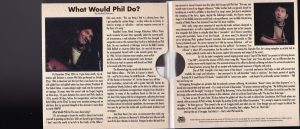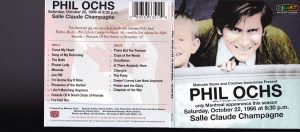I first encountered Phil Ochs via Terry B., a grade 12 Winnipeg guitarist-friend in early 1967, who shared some of the biting satire of his folk songs (“Draft Dodger Rage”, “I Ain’t Marching Anymore”, “Love Me, I’m a Liberal”) about the time I was discovering songs of his by other artists like Joan Baez (the plaintive “There But for Fortune”) and Ian and Sylvia (the delicate “Changes”). It was clear back then that he was a strong writer, like Dylan, though Ochs could not make a similar successful transition to mainstream and commercial music. (I should mention, in passing, his four main influences in his youth: John Wayne, James Dean, Buddy Holly, and Elvis Presley.)
(In the fall of 1967, I took a chance and bought Pleasures of the Harbor, his first album for a new record label co-founded by Herb Alpert, A & M, and was delighted by every song. Every song was a social commentary (like “Cross My Heart” and “Flower Lady”) and many of them were humorous and witty (like “Miranda”, “The Party”, and “Outside a Small Circle of Friends”). Other songs could be meanly bitter (like “I’ve Had Her”) and the album concluded with a bang (the apocalyptic soundscape of “The Crucifixion” about JFK’s assassination–still his ultimate social commentary on the violent American scene of the day which would continue to play out with several more prominent assassinations). If you listen to one Ochs album only, this is the one which is like nothing else ever written and produced.
Tape from California soon followed in 1968, with less production, and is more straightforward in many ways, though the lyrics’ imagery remains memorable, critical, and potent about American politics.
In 1969, he released Rehearsals for Retirement which was inspired by the disastrous and violent Chicago Democratic convention which saw Ochs and other rebels on the run from fascist police. His 1970 Gunfight at Carnegie Hall was a disastrous concert in which he tried a change of image, wearing an Elvis Presley gold lame suit, and singing songs by the likes of Merle Haggard, Buddy Holly and ‘The King’. About this period, it was clear that Ochs was bipolar and a very moody, depressed alcoholic who would go into a tailspin, culminating in his inability to write songs.
There would be one more interesting album, Greatest Hits, which was self-mockingly promoted by Ochs, given his overall lack of commercial success. Fearlessly, he continued to perform live and, currently, there is a new book of his writings and a CD of outtakes forthcoming this spring. Time has begun to catch up to Ochs and he is acquiring new fans belatedly, although his devoted hardcore fans have remained loyal to him from the ’60s on.
Two reasonable live albums have been available for some time now: the folky Phil Ochs Live at Newport, (1963-66) which showcases his early writing and performing. The second There and Now, was recorded in Vancouver in 1968, highlights a representative set of his best work, though some of the post-convention disillusionment had started to creep into his commentary. Recently, perhaps his best live concert (from 1966 in Montreal) has been posthumously released on 2 CDs. It is an impressive revelation with him playing the piano songs of Pleasures on guitar. It also reveals him in good characteristic voice with self-deprecating humor–a popular performer with crowds of the day. Highly recommended.
Two prominent books about Ochs’ life and career have been published; both are recommended. Schumacher has also written a concise summary of Ochs online worth finding and checking out; it is the most true boiled-down short overview of Ochs I’ve read thus far.
I first ran into this amazing document at a local library in 1968 when it first came out and some 40 years later, I was able to buy a copy of this rare songbook that had a limited printing. It contains the main songs recorded by then and has many visuals including large, page-sized photos taken of the singer by his wife Alice (who divorced him) and his manager-photographer Michael Ochs. It’s quite clear from the visuals that Ochs had a sense of humor, could make fun of himself, and enjoyed life until the late ’60s anyway. Later in 1976, succumbing to a sense of being a has-been and being irrelevant, in extreme depression, he hanged himself at the young age of only 35.
Although there are several CD compilations out there–(“The War Is Over” is one) and the hard-to-get, expensive American Troubadour Phil Ochs, the rare, out-of-print, 1997 Electra/Rhino Farewells & Fantasies retrospective is the one to get if you’re only buying one Ochs’ audio product. His daughter Meegan (pictured on Pleasures of the Harbor) and brother Michael have lovingly attended to the accompanying illustrated booklet and production of three CDs of well-chosen, representative material.
In 2010, Ochs got his first video retrospective tribute shown on PBS, which included Joan Baez, radical Tom Hayden, fellow-protest-singer-influence Pete Seeger, bad-boy-friend Sean Penn, Peter Paul and Mary’s Peter Yarrow, and radical journalist Christopher Hitchens. The result was an engaging 97-minute ode to this rebel-social activist-humanitarian, who tragically chose an unpopular, unconventional path to musical glory. Definitely, a must-have for fans.
………………………………………………………………………………
There is much, much more I could say about the folk singer who as equally interesting and even more outrageous than Bob Dylan. I will just close with the speculation that Dylan’s new 17-minute “Murder Most Foul” tribute to JFK may very well have been inspired by his friend Ochs’ mournful elegy to JFK, “The Crucifixion”.













